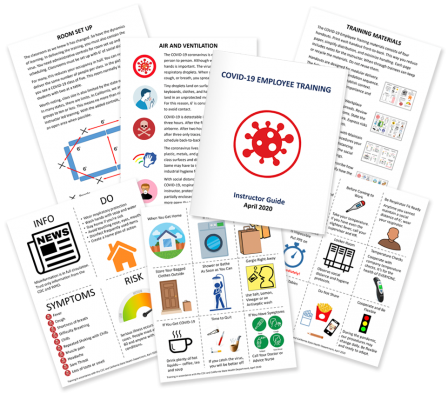Daily COVID-19 employee training self-checks prevent the spread of coronavirus.
A COVID-19 employee training self-check represents an essential behavior change. As a practice, employees often come to work sick. Typically, many do not give staying home consideration. For many wage-earners, they simply do not have sick time. With some organizations, sick time and vacation come from the same pool. In such cases, employees do not want to “waste†vacation days on illness.
PRE-PANDEMIC OFFICEÂ ETIQUETTE
In a similar vein, I worked for a startup South of Market. While the experience was short lived, the lesson was important. For context, the CEO, CTO, CMO, administrator and me shared an office. Being gracias, social distance was two to three feet with inadequate ventilation. During the flu season, the CEO came to work sick. As an alpha, he thought the flu should not keep anyone home.
After he caught the flu, he came to work. As you would expect, he spent the day sneezing and coughing. Reinforcing his delirium, he boasted about his stamina through his congestion. On the following day, he was too ill to commute. Over the next week, he stayed home, because he was so sick. During the week, the entire office came down with the flu. Lacking awareness, he never connected his poor choice to the productivity loss.
COVID-19 EMPLOYEEÂ TRAINING SELF-CHECK
Your COVID-19 employee training self-check means getting employees to stay home when sick. To prevent the virus spread, employees must stop coming to work when sick. As you would expect, this practice begins with leadership. Considering COVID-19’s fatality ratio, poor decisions maybe more than detrimental to efficiency. Moreover, they could prove fatal for high-risk employees. Beginning with management, we must recondition our thinking and behaviors. In every case, leadership begins with the example we live.
As part of COVID-19 employee training, workplace values must change too. For starters, employee health must be viewed in context to the organization. Controls for contractors without sick time must be addressed too. Simply stated, an organization cannot afford a COVID-19 infection. The consequences of infection and a shutdown outweigh the risk.
COVID-19 EMPLOYEEÂ TRAINING CONTROLS
For the economy to return, new administrative, procedural and PPE controls are needed. Your COVID-19 employee training self-check must include what to do when sick. Your procedures must also cover what to do when housemates are sick. The reason relates to the coronavirus’ highly infectious nature. According to the Statista Dossier, every COVID-19 infection leads to three more.
To operate through the pandemic, your success requires multiple forms of containment. Similarly, containment requires observing the health of housemates, like, your own. If your housemates show symptoms, you must assume you are already infected. Even if you are without symptoms, stay home. You could be asymptomatic or without symptoms for up to fourteen days. Even when it creates disruption, organizations must encourage responsible behavior. An employee’s decision to stay home outweighs their contribution to production.
COVID-19 EMPLOYEEÂ TRAINING HEALTH AND PREVENTION
Keep in mind, managing a labor shortage is better than an outbreak. Your COVID-19 employee training must reinforce this value. For operations to continue an employee self-check represents your first control. To be successful, your COVID-19 employee training must reinforce this behavior change. For containment overtime, self-checks must be practiced by all every day.
Act now to prevent COVID-19 in the workplace. Get ready with our proven COVID-19 Employee Training materials and Instructor Guide. Set up training with consideration for social distance, ventilation and PPE. Leverage single-use training materials. Prevention, hygiene, health and PPE it’s all there. Print and you’re ready to train. It’s a complete kit — Ready to go!


